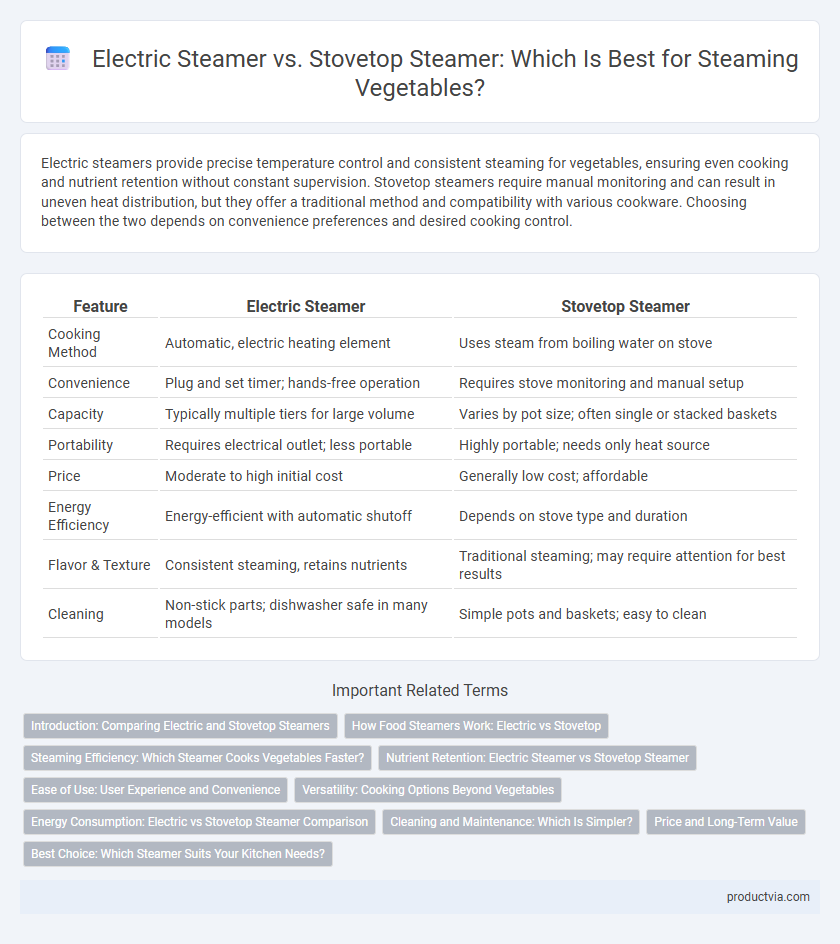Electric steamers provide precise temperature control and consistent steaming for vegetables, ensuring even cooking and nutrient retention without constant supervision. Stovetop steamers require manual monitoring and can result in uneven heat distribution, but they offer a traditional method and compatibility with various cookware. Choosing between the two depends on convenience preferences and desired cooking control.
Table of Comparison
| Feature | Electric Steamer | Stovetop Steamer |
|---|---|---|
| Cooking Method | Automatic, electric heating element | Uses steam from boiling water on stove |
| Convenience | Plug and set timer; hands-free operation | Requires stove monitoring and manual setup |
| Capacity | Typically multiple tiers for large volume | Varies by pot size; often single or stacked baskets |
| Portability | Requires electrical outlet; less portable | Highly portable; needs only heat source |
| Price | Moderate to high initial cost | Generally low cost; affordable |
| Energy Efficiency | Energy-efficient with automatic shutoff | Depends on stove type and duration |
| Flavor & Texture | Consistent steaming, retains nutrients | Traditional steaming; may require attention for best results |
| Cleaning | Non-stick parts; dishwasher safe in many models | Simple pots and baskets; easy to clean |
Introduction: Comparing Electric and Stovetop Steamers
Electric steamers offer precise temperature control and timed cooking, ensuring consistent vegetable steaming with minimal supervision. Stovetop steamers rely on the heat source and require close monitoring but provide versatility for various pot sizes and direct steam intensity. Both methods retain nutrients effectively, yet electric steamers enhance convenience with automated settings for optimized vegetable texture and flavor.
How Food Steamers Work: Electric vs Stovetop
Electric food steamers use an integrated heating element to boil water and produce consistent steam, allowing precise temperature control and timed cooking for vegetables. Stovetop steamers rely on a pot of boiling water on a gas or electric burner, with steam rising through a perforated basket to cook vegetables, offering manual heat adjustments. Both methods utilize steam's moist heat to preserve nutrients and texture, but electric steamers provide automated, hands-free operation while stovetop steamers depend on user monitoring.
Steaming Efficiency: Which Steamer Cooks Vegetables Faster?
Electric steamers typically cook vegetables faster than stovetop steamers due to precise temperature control and consistent steam distribution. Their built-in timers and automatic shut-off features optimize cooking time, reducing the risk of overcooking. Stovetop steamers rely on manual heat adjustment, which can result in slower and less even steaming.
Nutrient Retention: Electric Steamer vs Stovetop Steamer
Electric steamers consistently maintain higher nutrient retention in vegetables due to precise temperature control and even steam distribution, minimizing vitamin and mineral loss. Stovetop steamers, while effective, often expose vegetables to fluctuating heat levels and longer cooking times, which can degrade sensitive nutrients like vitamin C and folate. Studies show electric steamers preserve up to 20% more antioxidants compared to traditional stovetop methods, making them superior for nutrient-rich vegetable preparation.
Ease of Use: User Experience and Convenience
Electric steamers offer superior ease of use with programmable timers and automatic shut-off features that simplify vegetable steaming without constant supervision. Stovetop steamers require manual monitoring and temperature adjustments, making them less convenient for multitasking in the kitchen. The hands-off operation of electric steamers enhances user experience by providing consistent results with minimal effort.
Versatility: Cooking Options Beyond Vegetables
Electric steamers offer greater versatility with multiple preset cooking programs and the ability to steam a variety of foods such as fish, poultry, and grains, enhancing meal variety. Stovetop steamers require manual temperature and timing control, suitable mainly for vegetables but less adaptable for complex cooking tasks. Advanced electric steamers often include features like delay timers and keep-warm functions, making them ideal for diverse culinary applications beyond simple vegetable steaming.
Energy Consumption: Electric vs Stovetop Steamer Comparison
Electric steamers consume less energy compared to stovetop steamers due to precise temperature control and shorter cooking times. Stovetop steamers often require higher heat for prolonged periods, leading to increased fuel or electricity usage. Energy-efficient electric models also reduce overall power consumption, making them a sustainable choice for vegetable steaming.
Cleaning and Maintenance: Which Is Simpler?
Electric steamers feature removable, dishwasher-safe parts that streamline cleaning and reduce maintenance time, while stovetop steamers often require manual scrubbing to remove food residue and mineral buildup. The electric steamer's self-contained design minimizes hard-to-reach areas, simplifying upkeep. Users prioritizing ease of cleaning typically find electric steamers more convenient for regular vegetable steaming.
Price and Long-Term Value
Electric steamers offer a higher upfront cost but provide consistent temperature control and programmable settings, enhancing cooking precision for vegetables. Stovetop steamers are generally more affordable initially but require manual monitoring and may not deliver uniform steaming, possibly affecting long-term usability. Considering durability and energy efficiency, electric steamers can offer better long-term value despite the higher price.
Best Choice: Which Steamer Suits Your Kitchen Needs?
Electric steamers offer precise temperature control and timer settings, making them ideal for consistent vegetable cooking with minimal supervision. Stovetop steamers provide versatility and are typically more affordable, but require close attention to water levels and heat adjustments. Choosing the best steamer depends on your kitchen space, cooking frequency, and preference for automation versus traditional methods.
Electric steamer vs Stovetop steamer for vegetables Infographic

 productvia.com
productvia.com